Abstract
Structural and geometric photoisomerization of bilirubin bound to human serum albumin was investigated. Solutions were irradiated with monochromatic light emitted by an Ar ion laser, the 457.9, 488.0 and 514.5 nm wavelengths being selected. Photoproducts were separated and analysed by h.p.l.c. Visible-absorption spectra of pure ZZ-bilirubin, ZE-bilirubin and lumirubin in the eluent were registered in the 350-550 nm region by collecting single fractions by h.p.l.c. Wavelength-dependence of bilirubin photoconversion was studied within photoequilibrium and up to a large decrement of the total concentration. Experiments were performed in aerobic and anaerobic conditions in order to assess the contribution of the photo-oxidation to the overall process. The presence of O2 was found to increase the rate of bilirubin degradation and unexpectedly to favour lumirubin production. The ability of 514.5 nm irradiation to induce bilirubin cyclization was definitively confirmed.
Full text
PDF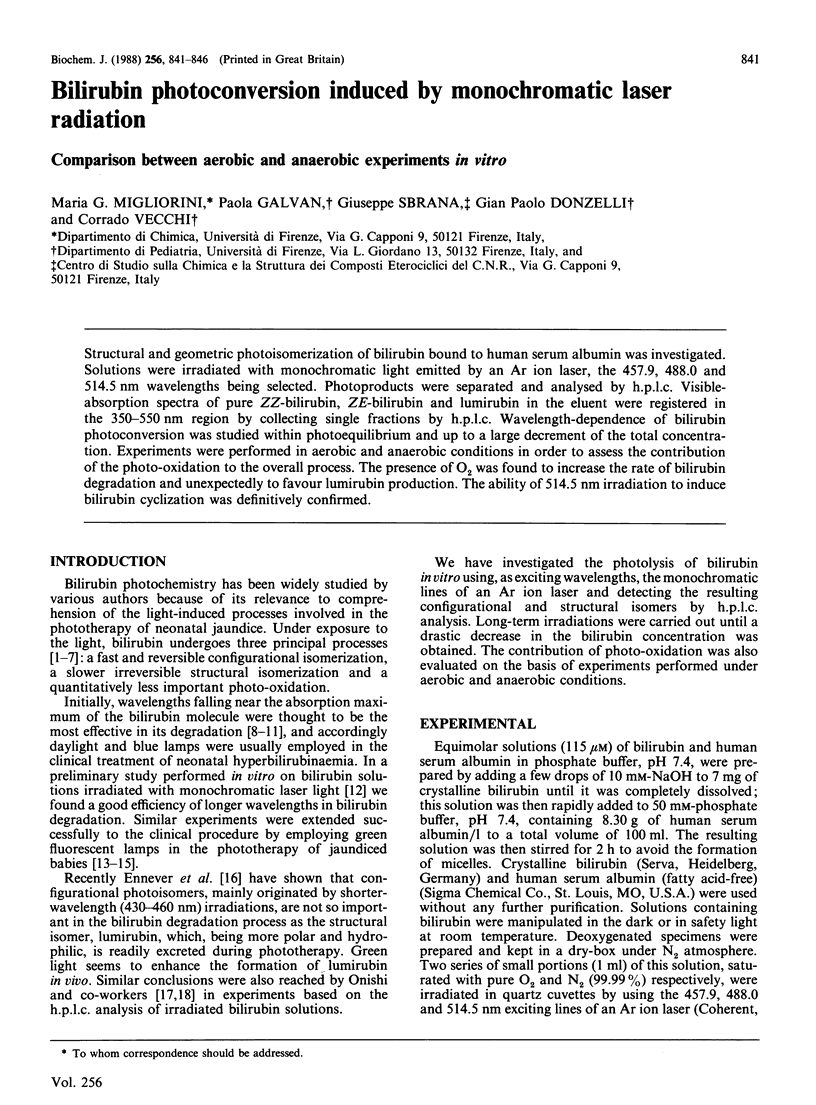
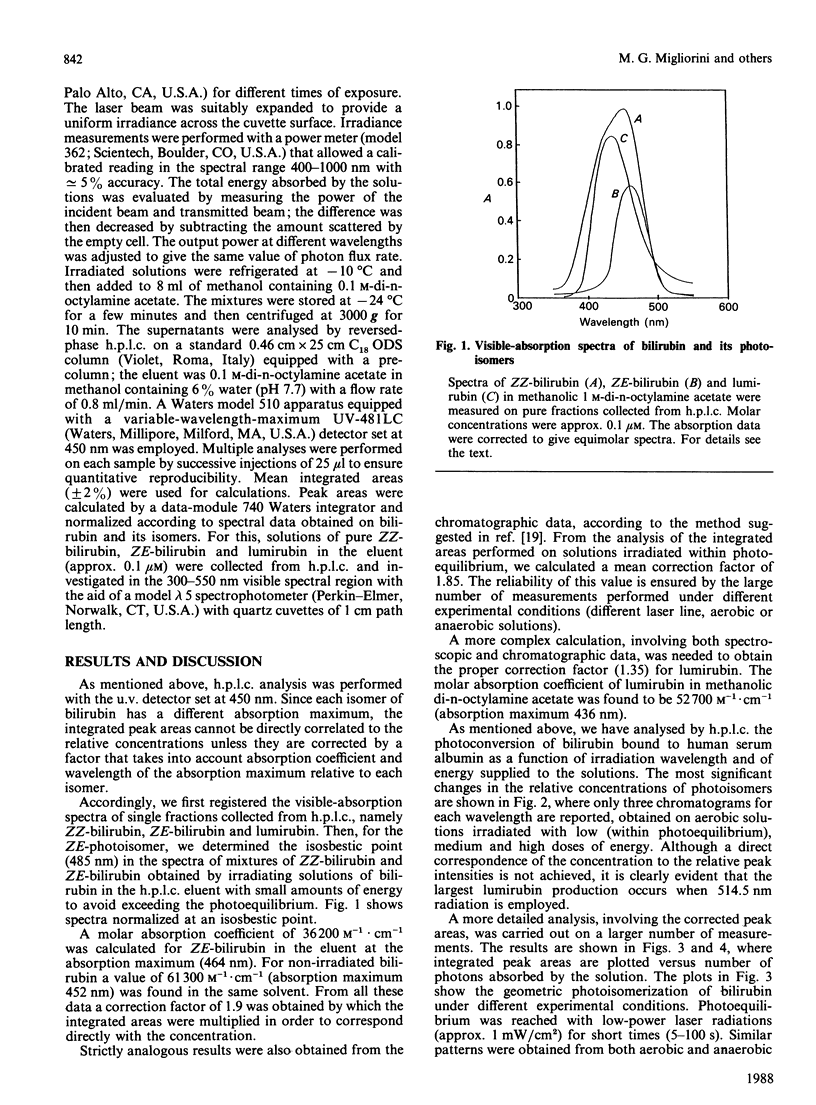
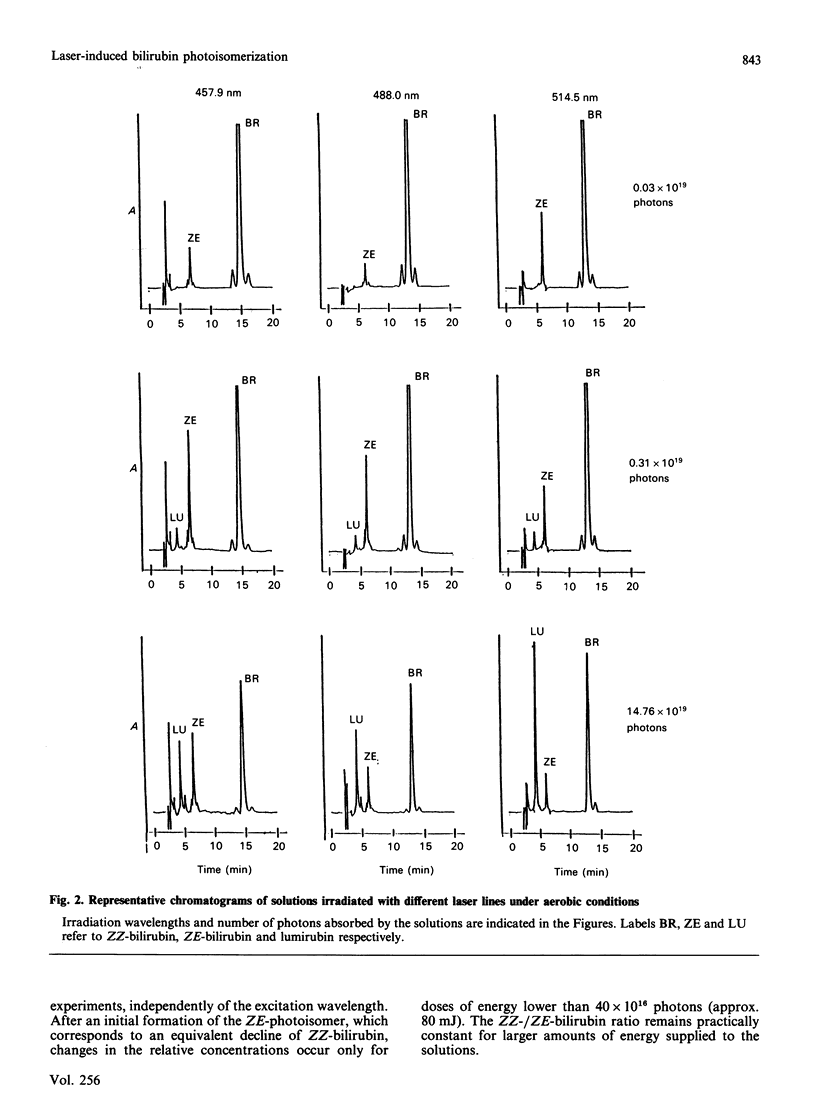
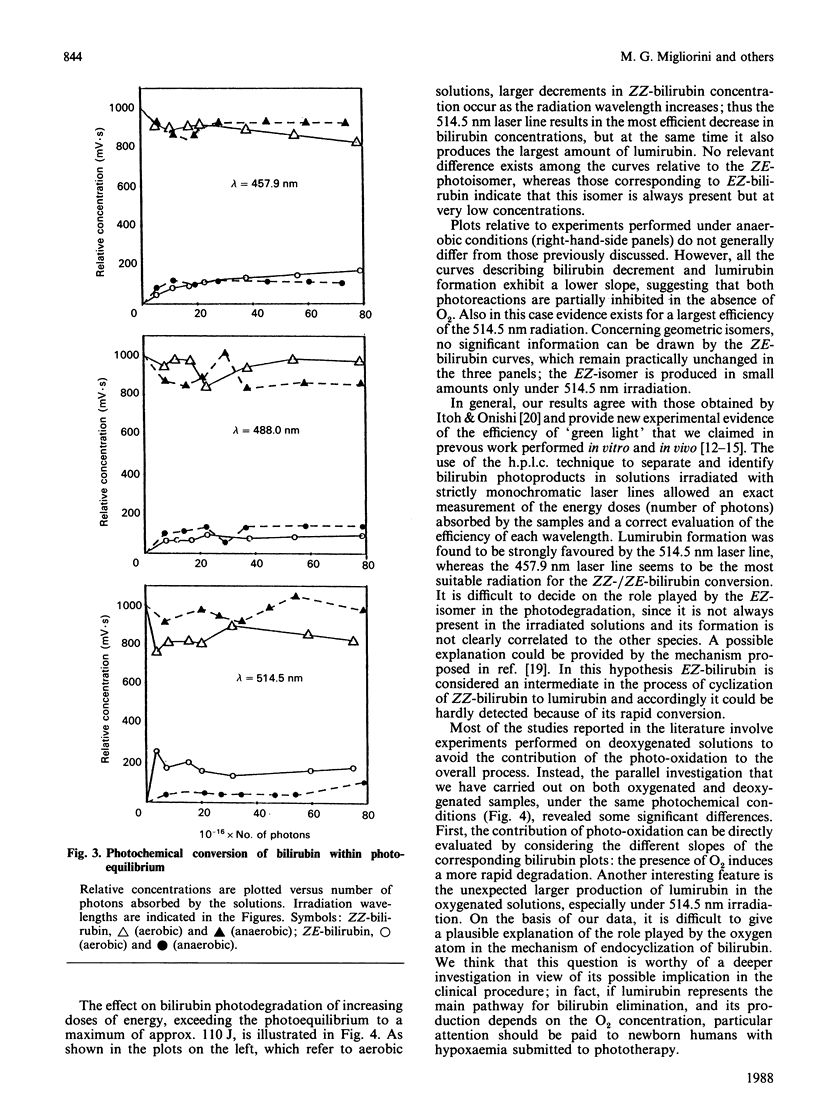

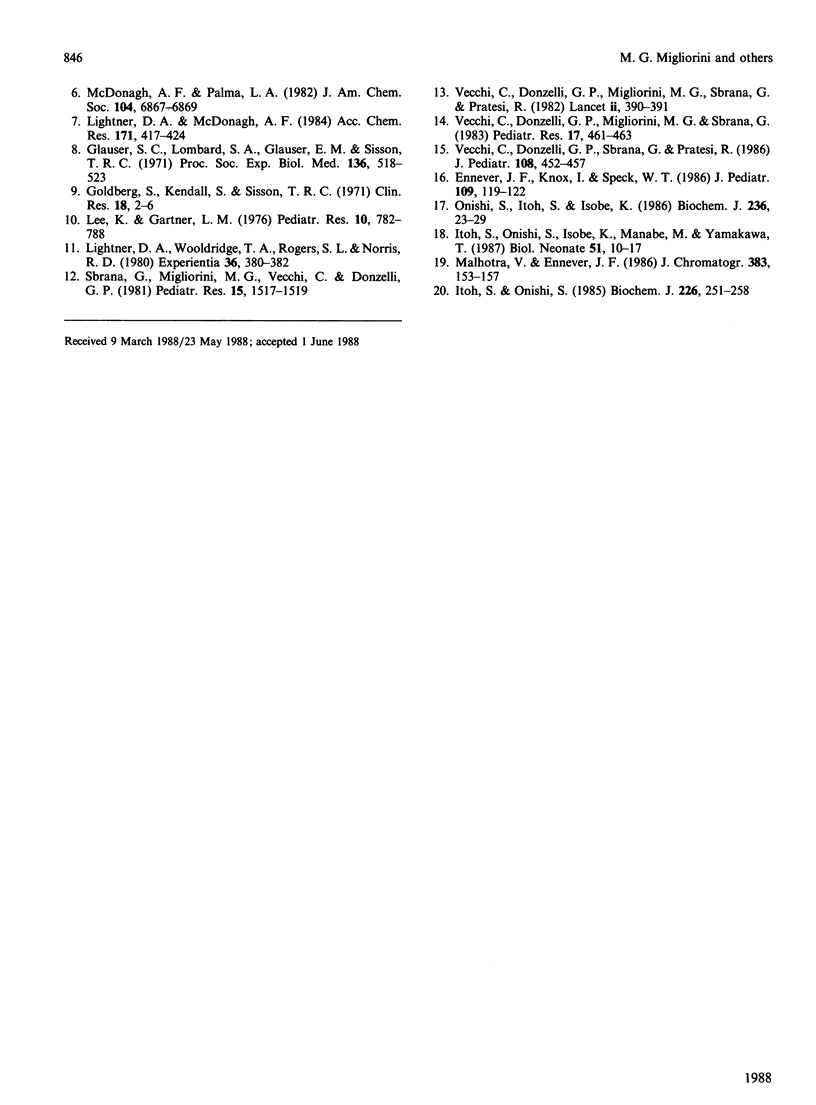
Selected References
These references are in PubMed. This may not be the complete list of references from this article.
- Ennever J. F., Knox I., Speck W. T. Differences in bilirubin isomer composition in infants treated with green and white light phototherapy. J Pediatr. 1986 Jul;109(1):119–122. doi: 10.1016/s0022-3476(86)80590-x. [DOI] [PubMed] [Google Scholar]
- Glauser S. C., Lombard S. A., Glauser E. M., Sisson T. R. Action spectrum for the photodestruction of bilirubin. Proc Soc Exp Biol Med. 1971 Feb;136(2):518–519. doi: 10.3181/00379727-136-35302. [DOI] [PubMed] [Google Scholar]
- Itoh S., Onishi S., Isobe K., Manabe M., Yamakawa T. Wavelength dependence of the geometric and structural photoisomerization of bilirubin bound to human serum albumin. Biol Neonate. 1987;51(1):10–17. doi: 10.1159/000242625. [DOI] [PubMed] [Google Scholar]
- Itoh S., Onishi S. Kinetic study of the photochemical changes of (ZZ)-bilirubin IX alpha bound to human serum albumin. Demonstration of (EZ)-bilirubin IX alpha as an intermediate in photochemical changes from (ZZ)-bilirubin IX alpha to (EZ)-cyclobilirubin IX alpha. Biochem J. 1985 Feb 15;226(1):251–258. doi: 10.1042/bj2260251. [DOI] [PMC free article] [PubMed] [Google Scholar]
- Lee K. S., Gartner L. M. Spectrophotometric characteristics of bilirubin. Pediatr Res. 1976 Sep;10(9):782–788. doi: 10.1203/00006450-197609000-00004. [DOI] [PubMed] [Google Scholar]
- Lightner D. A., Wooldridge T. A., Rodgers S. L., Norris R. D. Action spectra for bilirubin photodisappearance. Experientia. 1980 Apr 15;36(4):380–382. doi: 10.1007/BF01975098. [DOI] [PubMed] [Google Scholar]
- Malhotra V., Ennever J. F. Determination of the relative detector response for unstable bilirubin photoproducts without isolation. J Chromatogr. 1986 Nov 28;383(1):153–157. doi: 10.1016/s0378-4347(00)83454-4. [DOI] [PubMed] [Google Scholar]
- Onishi S., Isobe K., Itoh S., Kawade N., Sugiyama S. Demonstration of a geometric isomer of bilirubin-IX alpha in the serum of a hyperbilirubinaemic newborn infant and the mechanism of jaundice phototherapy. Biochem J. 1980 Sep 15;190(3):533–536. doi: 10.1042/bj1900533. [DOI] [PMC free article] [PubMed] [Google Scholar]
- Onishi S., Itoh S., Isobe K. Wavelength-dependence of the relative rate constants for the main geometric and structural photoisomerization of bilirubin IX alpha bound to human serum albumin. Demonstration of green light at 510 nm as the most effective wavelength in photochemical changes from (ZZ)-bilirubin IX alpha to (EZ)-cyclobilirubin IX alpha via (EZ)-bilirubin. Biochem J. 1986 May 15;236(1):23–29. doi: 10.1042/bj2360023. [DOI] [PMC free article] [PubMed] [Google Scholar]
- Onishi S., Kawade N., Itoh S., Isobe K., Sugiyama S. High-pressure liquid chromatographic analysis of anaerobic photoproducts of bilirubin-IX alpha in vitro and its comparison with photoproducts in vivo. Biochem J. 1980 Sep 15;190(3):527–532. doi: 10.1042/bj1900527. [DOI] [PMC free article] [PubMed] [Google Scholar]
- Sbrana G., Migliorini M. G., Vecchi C., Donzelli G. P. Laser photolysis of bilirubin. Pediatr Res. 1981 Dec;15(12):1517–1519. doi: 10.1203/00006450-198112000-00013. [DOI] [PubMed] [Google Scholar]
- Stoll M. S., Zenone E. A., Ostrow J. D., Zarembo J. E. Preparation and properties of bilirubin photoisomers. Biochem J. 1979 Oct 1;183(1):139–146. doi: 10.1042/bj1830139. [DOI] [PMC free article] [PubMed] [Google Scholar]
- Vecchi C., Donzelli G. P., Migliorini M. G., Sbrana G. Green light in phototherapy. Pediatr Res. 1983 Jun;17(6):461–463. doi: 10.1203/00006450-198306000-00006. [DOI] [PubMed] [Google Scholar]
- Vecchi C., Donzelli G. P., Migliorini M. G., Sbrana G., Pratesi R. New light in phototherapy. Lancet. 1982 Aug 14;2(8294):390–390. doi: 10.1016/s0140-6736(82)90584-0. [DOI] [PubMed] [Google Scholar]
- Vecchi C., Donzelli G. P., Sbrana G., Pratesi R. Phototherapy for neonatal jaundice: clinical equivalence of fluorescent green and "special" blue lamps. J Pediatr. 1986 Mar;108(3):452–456. doi: 10.1016/s0022-3476(86)80895-2. [DOI] [PubMed] [Google Scholar]


